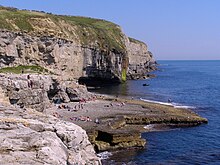Purbeck Stone
Purbeck Stone (German Purbeck stone ) is a sedimentary rock . Like the Purbeck Marble, it is mainly extracted on the Isle of Purbeck peninsula in the county of Dorset on the south coast of England .
Emergence
The Isle of Purbeck is geologically complex. Many types of fossil- containing limestone were deposited in the late Jurassic ( Kimmeridgian and Tithonian ) and early Cretaceous ( Berriasian ) periods. The deposits took place alternating between salt and fresh water in sea bays around 155 to 141 million years ago (former Purbeck stage). Initially, clay was deposited on the bottom of the sea bays. This was followed by Portland sand and layers of Purbeck stone and Portland . Shells, fish and reptiles were deposited in the layers of the Purbeck Stone.
The layers of crystalline limestone have different colors from gray-blue to beige. Each layer is unique because of its fossils. Numerous traces of dinosaurs have also been found. The top layer of the Purbeck stone is the Purbeck marble, underneath there are red or green colored variations. These layers get their color from mineral impurities and lie between layers of soft clay and mudstone .
Extraction
Purbeck's limestones have been worked since Roman times until today, possibly as early as the Bronze Age. In commercial mining, a distinction is made between 24 different layers. These differ in their characteristic fossil molluscs.
The foothills of the Purbeck limestone along the north side of the peninsula are marked by many medieval and modern pits. Roman mines have not been identified; it is believed that these were covered by later quarries. There are several suspected Roman quarries, the most likely locations being at Wilkswood, Dunshay Manor and Worbarrow .
The Isle of Purbeck is known for its coastline and landscape. The quarrying extends along the coast from Swanage , Langton Matravers , Acton to Worth Matravers . Purbeck stone was also extracted further west in the Blashenwell Farm Pit in Corfe Castle parish . Even Dancing Ledge was once a quarry. Tilly Whim Caves consists of three former quarries. The former Belle Vue Quarry quarry was declared an Area of Special Scientific Interest in 1977.
In the past, the stone was mined underground, today in open-cast mining . The rock is mechanically mined in the spring and stacked to dry during the summer. This way the stone will not crack if the temperature drops below freezing in winter.
use
Purbeck marble is darker than the limestone. Purbeck stone is more weather-resistant than marble. Purbeck marble is rarely mined, mostly for repair work. But it is also used by a number of contemporary sculptors. In contrast, the limestone is still intensively mined today.
During the Roman period, Purbeck marble was used for inscription plates, architectural moldings or cladding, mortars and pestles. Purbeck marble was also quarried in the Middle Ages and can be seen as pillars and flooring in almost all churches and cathedrals in the south of England. Purbeck marble was used for the interior stonework and floors of Westminster Abbey . Purbeck stone was used for the masonry of many other churches. In modern times, marble was used less. A notable example is St James Church in Kingston (Dorset) , built between 1874 and 1880. The builder was John Scott the 3rd Earl of Eldon (1845–1926) and the architect was the well-known church architect George Edmund Street (1824–1881) .
The lower layers of the Purbeck stone are mostly used as permanent building material or as roof panels. All layers were used for a variety of purposes, such as in church buildings, memorials and garden decoration. Almost all the houses in the villages of Corfe Castle , Kingston , Worth Matravers , Langton Matravers and Acton are built of Purbeck stone, and most of them are roofed with stone.
John Mowlem (1788–1868) and his nephew George Burt (1816–1894), both from Swanage, became successful building contractors in London. They built their business with the import of Purbeck limestone and built many sidewalks, bridges and houses in London with Purbeck stone, including Queen Victoria Street (1869), the Billingsgate Fish Market (1874-77) and the City of London School (1880).
Web links
Individual evidence
- ↑ Information on soton.ac.uk
- ↑ JBCalkin, "Early Bronze Age remains at Lynchard, Langton Matravers, and a summary of other local EBA discoveries", 116-118, 1960
- ↑ (Coach House Museum, Langton Matravers - Museum of the Purbeck quarry industry)
- ↑ Possible Roman Purbeck Marble quarry sites Archived copy ( Memento of the original from July 6, 2008 in the Internet Archive ) Info: The archive link was inserted automatically and has not yet been checked. Please check the original and archive link according to the instructions and then remove this notice. English
- ↑ http://www.english-nature.org.uk/citation/citation_photo/1002399.pdf Notification Document SSSI (English)



